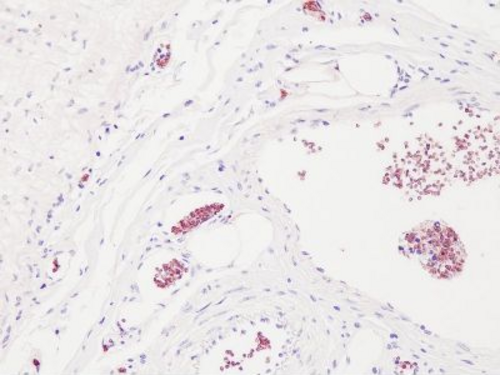HBB Mouse Monoclonal Antibody [Clone ID: PLA114]
Other products for "HBB"
Specifications
| Product Data | |
| Clone Name | PLA114 |
| Applications | ELISA, IHC |
| Recommended Dilution | Tested for immunohistochemistry (IHC) and Western Blot, other applications not yet tested. Approximate working dilutions: IHC, frozen sections: 0.2µg/ml (1:2000) IHC, paraffin sections: 10µg/ml (1:40) Western Blot: 0.25µg/ml (1:2000) Optimal dilutions should be determined by the end user. |
| Reactivities | Porcine |
| Host | Mouse |
| Isotype | IgG1 |
| Clonality | Monoclonal |
| Immunogen | Porcine liver extract. |
| Specificity | Pig: Erythrocytes, plasma
Other species: not tested Epitope: Immunoprecipitation and subsequent identification by nanoLC- ESI-MS/MS identified the antigen as hemoglobin beta chain. The epitope has not been further characterized. Distribution: Tissue sections: In paraffin sections the antibody stains all erythrocytes whereas in frozen sections the antibody yields a picture typical of a molecule leaking out of blood vessels and diffusing into surrounding tissue. |
| Formulation | Affinity purified from cell culture supernatant, lyophilized. Reconstitute by adding 0.5ml distilled water. This stock solution contains 0.4mg/ml IgG, phosphate buffered saline pH 7.2 (PBS), 5mg/ml bovine serum albumin (BSA) as a stabilizer and 0.05% (v/v) Kathon CG as a preservative. |
| Concentration | N/A |
| Conjugation | Unconjugated |
| Storage | Original vial: 1 year at 4° - 8°C. Avoid repeated thawing and freezing of the reconstituted antibody. |
| Database Link | |
| Background | Monoclonal antibody PLA114 is specifically directed against the porcine hemoglobin beta subunit. Hemoglobin contains four subunits, of which two are identical. They form the α2β2 scaffold that holds the iron-containing heme group which is responsible for oxygen transport by red blood cells. Each subunit has a molecular weight of about 16kDa. In humans, the beta-globin gene is activated around the time of birth, replacing embryonic and fetal globin genes. In humans, mutations in the adult β-globin gene cause β-thalassemia and sickle cell disease (SCD). β-Thalassemia results from a reduced production of β-globin while SCD is caused by a mutation that results in an amino acid substitution of adult β-globin. Hemoglobin tetramers bearing this mutation polymerize inside red blood cells and distort them into a characteristic crescent-shaped appearance. These rigid sickle cells are more prone to lysis and tend to occlude blood flow in the microvasculature, causing severe physiological problems. This antibody was produced serum-free, without fetal calf serum. |
| Synonyms | beta-globin; CD113t-C; HBD |
| Reference Data | |
Documents
| Product Manuals |
| FAQs |
| SDS |
{0} Product Review(s)
0 Product Review(s)
Submit review
Be the first one to submit a review
Product Citations
*Delivery time may vary from web posted schedule. Occasional delays may occur due to unforeseen
complexities in the preparation of your product. International customers may expect an additional 1-2 weeks
in shipping.






























































































































































































































































 Germany
Germany
 Japan
Japan
 United Kingdom
United Kingdom
 China
China




